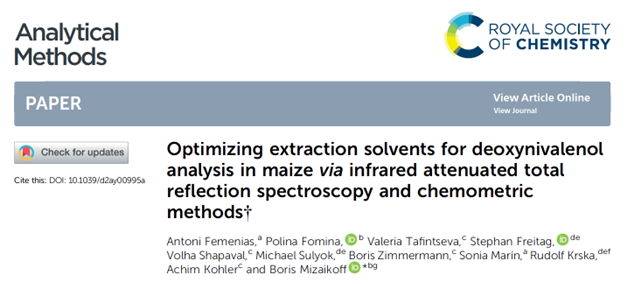The PHOTONFOOD partners have recently published a scientific peer-reviewed paper focused on ‘Optimizing extraction solvents for deoxynivalenol analysis in maize via infrared attenuated total reflection spectroscopy and chemometric methods’.

A collaborative research handled by UULM, NMBU and BOKU teams on the comparative study of different extraction solvents to achieve a fast, eco-friendly and cost-effective analysis of mycotoxins in cereal products by infrared attenuated total reflection is now available in Analytical Methods. This study includes promising results to discriminate maize batches contaminated with deoxynivalenol concentration levels out of EU standards using small amounts of solvent.
In this new work, the authors designed an extraction procedure via different solvents optimizing its performance specifically for IR sensing techniques. Bio-based and non-bio-based solvents were evaluated to demonstrate the feasibility of green solvents in the extraction system. The IR spectral features of fungal infected and high DON contaminated maize could be related with changes in protein, carbohydrates and lipidic content that would be the key for indirect deoxynivalenol content determination.
This early work has implications for IR sensing of fungal-related infections in food commodities, which are directly associated with consumer’s health disorders and producer’s negative economic impacts. In addition, the study proposes eco-friendly solvents as the final solution to replace hazardous chemicals massively used in routine analysis. Therefore, it may have the potential for one day monitoring contamination on site at very low detection levels. The authors encourage you to check it out online via https://doi.org/10.1039/d2ay00995a.
By Antoni Femenias Llaneras, UULM
